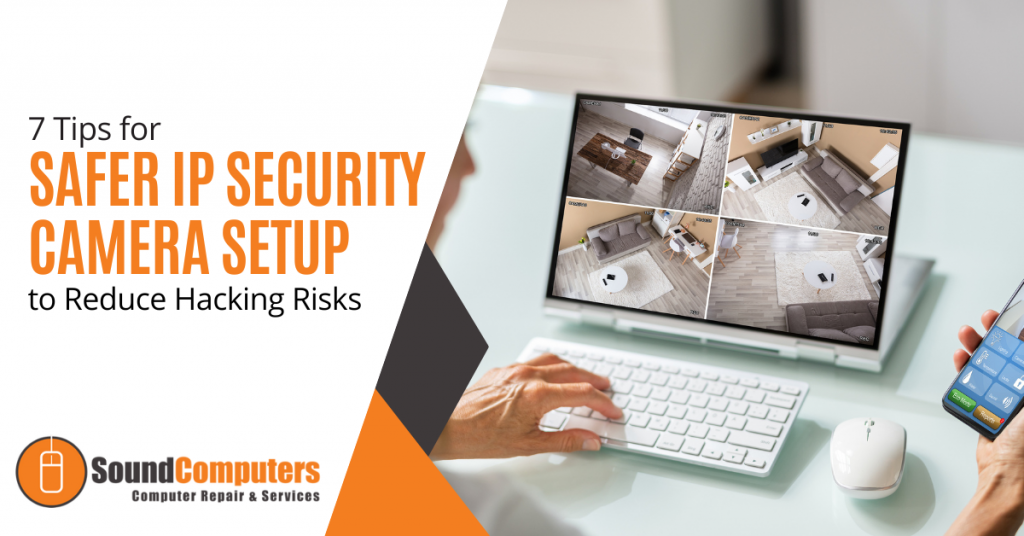
Modern video surveillance systems contain a number of critical components including IP (Internet Protocol) cameras. IP surveillance cameras (that transmit and receive information through a computing network and via the internet) offer organizations a range of advantages over analog closed-circuit cameras. They can watch and manage their video security system remotely and store video footage in the cloud to allow for significant cost savings.
However, similar to any equipment connected to the internet, the IP surveillance cameras you put in place to increase security in your company can really make it more prone to network and physical attacks if cybersecurity is not properly addressed.
According to a report, 70% of data from security cameras (in the US) was breached a few days before the inauguration of a past president. That is high. However, for small and medium-sized companies, it is essential to employ various effective security strategies to secure their IP security camera data to avoid a data breach.
Methods of Reducing Hacking Risks for IP Security Cameras
Here are some effective measures that business owners need to carry out to avoid data breaches:
1. Use only local-network cameras.
Don’t link your cameras to the internet if you do not want your feeds to be shared online.
Keep your security cameras/devices within your local environment and provide them with non-routable internal IP addresses if privacy is your main goal. Camera software that uses UPNP or port forwarding to link your security cameras/devices to the internet may still be able to expose your security cameras even if they have non-routable IP addresses.
You can go to the IP camera’s website to understand how to install your security cameras in local-only mode.
2. Update the firmware on your security camera.
Most current IP security cameras have firmware that the users can upgrade. The vendor of the IP surveillance camera will frequently release a firmware upgrade to address any discovered security flaws. You may use a web browser to upgrade the firmware of your camera through the admin console.
To ensure that the firmware you use doesn’t contain an unencrypted vulnerability that cybercriminals and cyber-spies may leverage, you should routinely check the manufacturer of your IP security camera’s website for updates.
3. Password-protect your cameras.
Password security isn’t always enabled on IP cameras. After the first setup, some users neglect to enable password protection which makes the cameras accessible to everyone.
Almost all cameras provide some simple authentication procedures. Even though it isn’t very strong, it is still better than no procedures. With a strong id and frequent password changes, you can secure your camera feeds.
4. Reduce data sharing.
The possibility that you will need to register an account before you can install your security camera is high. You might be able to completely skip this step with some brands. Some terms and conditions will be shown to you throughout the onboarding process while others (such as sharing specific categories of data with the business) are optional.
Therefore, it is a good idea to be aware of the terms and conditions that you are consenting to in the process of installing your device. Certain brands will need a larger amount of information than others.
5. Adopt 2FA (Two-Factor Authentication).
Two-factor authentication (2FA), also known as two-step verification, adds additional protection to your password or PIN to confirm your identity. Before you sign in to your account, 2FA typically requires you to provide extra information such as an OTP (one-time generated code) provided via phone call, text message or email to verify your identity.
Enabling 2FA makes your account more secure against unwanted access even if someone manages to guess or steal your password. The Google Authenticator Software is a very helpful tool that can assist with two-factor authentication.
6. Put all software upgrades in place.
These offer new essential security measures against security risks. To avoid needing to remember to perform updates, check if you can set up the camera to do it automatically in the Settings section.
7. Stop cameras from transmitting data to outside parties.
Even though the video from security cameras is crucial to many individuals, businesses that use them frequently do not make enough effort to secure their security cameras and the information they convey.
Most camera firmware from various manufacturers is programmed to keep a link with the product’s server without the user’s knowledge. The majority of users (both individual and business) are ignorant of this and do not take any precautions to guard against this potential issue that could lead to the leak of video to the public or a successful cyber-attack.
Protect Your IP Security Camera with Sound Computers
Sound Computers have been providing small and medium-sized companies in the Connecticut region with IT support including technical helpline support, computer support and consultancy. Every action we do is intended to proactively increase your productivity and allow technology to boost your company’s profitability.
For further support, contact us.